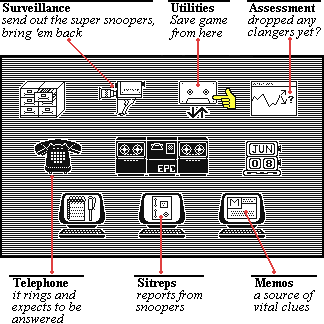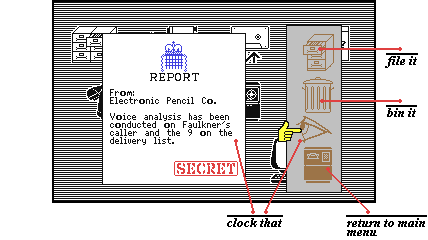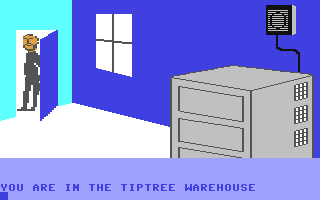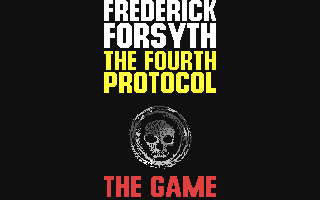| |
 |
 |
 |
 |
 |
 |
 |
 |
 |
 |
 |
| |
|
|
| |
|
| |
Please
sign our
Guestbook!
Can
you help us?
missing games
games with bugs
Please
Vote for us at

Please
Rate this Site at


Website
design &
programming
(c) 2000 James Burrows
|
| |
|
| |
|
| |
 |
| |
The Fourth Protocol
is a thinking man's Shadowfire,
but you mustn't think that makes it boring, this
is a really involving adventure with some arcade
overtones, and using the icons makes it all so
simple to get into. It kicks off with an amazingly
crisp-looking title screen and fantastic music,
just about the best I've heard on the 64 yet.
.
|
| |
 |
| |
What
can I say about the game itself? Well, imagine
yourself in a busy office, surrounded by filing
cabinets, computers and phones, with the resources
of the Intelligence Community behind you and a
fearsome problem to sort out. The excitement starts
immediately as the puzzles mount up in your filing
cabinet and the 'bin' begins to overflow with
discarded leads. I think the best thing to say
about this game is BUY IT!
.
|
| |
 |
| |
To be honest, I have never considered myself as
an adventure freak; I find the whole business
just too upsetting and frustrating. However, The
Fourth Protocol
removes the excuse so gracefully that even arcade
fans can't say, 'Oh I just can't cope with the
text input and all that'. The icons make it an
absolute joy to play.
.
|
| |
 |
| |
I
found the hardest task of the game was sorting
out the good information from the bad, for instance,
I often assigned watchers to FO staff who were
acting a little strange, only to find, in one
case, that the chap was only having a liaison
of the non-espionage sort. My progress through
the game to date has been slow -- there is a deal
to learn and some of the clues are very subtle.
.
|
| |
 |
| |
I am still excited by The
Fourth Protocol even
after long evenings of play. The thrill as I think
up a new lead to pursue, the despondency when
it leads nowhere, the nail biting anticipation
as I wait for the Sitreps that may, or may not,
confirm a hunch. All of these go to build up an
almost unbelievable atmosphere. Last night I was
Preston trying to find the little creeps responsible
for the leaks. Only when I stood up to assume
a more threatening pose after getting yet another
unpleasant memo from Plum and tripped over a defunct
64 left by the reckless Rignall did I come down
to Earth.
.
|
| |
|
|
|
|
|
 |
|
| Welcome
to Game of the Week! Each week there will be a
new featured game on this page. The game may be good,
average or diabolically bad, it really doesn't matter!
Just look at the pics, read the text and enjoy the nostalgia!
:-) Game of the Week! is open to contributions so if you
would like to contribute
a game article for this page you're more than welcome
to! Every article we receive will be considered! |
|
|
The
Fourth Protocol
1985 Hutchinson
Computer Publishing
Programmed
by John P. Gibbons
|
| |
| Most
text of the present article comes from the review published
in the fourth issue of the British C64 magazine ZZAP!64
(August 1985). |
| |
|
|
 |
|
THE
FOURTH PROTOCOL
Hutchinson
Computer Publishing, £12.95 cass, £15.95
disk, keys
only
|
 .AUGUST
.AUGUST
|
Frederick Forsythe has enjoyed great success as
a novelist of political fiction and many films
have been adapted, with mixed success, from his
books. The Fourth Protocol is the first
to become a game.
At
the outset it is important to say that this is
an adventure, or rather three adventures in one,
that is played using icons with some text input.
|
|
|
The
plot follows that of the book quite closely. You play
a medium level MI5 investigator, John Preston, a man
who is more of a detective than a spy. From the highest
levels of the Kremlin, Plan Aurora is being executed.
Using Russian agents in Britain, 'sleepers', 'illegals'
and the unfortunate Ministerial victims of blackmail,
a crack Soviet agent is putting together the pieces
of the jigsaw that will blast the Fourth Protocol wide
open. This piece of diplomatic etiquette is supposedly
the fourth secret agreement which forbids a signatory
country smuggling a nuclear device onto another's territory;
it was appended to the 1968 Nuclear Non-Proliferation
Treaty. Now the Soviets are breaking the protocol by
smuggling into Britain the unassembled parts of a bomb
and technicians working 'blind' to put it together.
The aim is to detonate it in the proximity of an American
Air Force base just before a general election, thus
stirring public opinion (already being subtly helped
towards confrontation with the Americans) to have them
thrown out at the same time as ushering in a strongly
co-operative communist-inspired Labour Government, which
will withdraw the UK from NATO.

John
Preston in the book uncovers a variety of apparently
unrelated leads; but leads to what and where? He is
also thwarted by his own promotion-conscious bosses,
as well as the mind-boggling proportions of the plot
that begins to emerge. These elements are reflected
in the game as well, but the player Preston starts with
foreknowledge of what is about to happen -- it is the
how and whom that form the substance of the games.

The
three parts to The Fourth Protocol are actually
individual games: part one is called The NATO Documents,
part two is The Bomb and part three is The
SAS Assault. You can only reach the conclusion by
succeeding first at each part in turn. Part one follows
the book's plot: a highly placed man in the Ministry
of Defence has some famous diamonds stolen from the
secret safe of his central London flat. He can't report
the burglary because along with the diamonds went some
NATO documents that shouldn't have been there. The burglar,
however, who is no ordinary thief, recognises the importance
of the documents and being a patriotic criminal, sends
them anonymously to the MoD Mandarins to alert them
to the leak. The investigation is on. The object is
to discover who is leaking the documents, to whom, and
for what purpose. But MI5 investigator Preston has more
on his plate -- dead-end leads, false leads, irrelevant
leads and several that may link up are being thrown
at him continually.

The
SAS team are tooled up and raring to go.
In
The Bomb, the action moves outside Preston's
office, as finding the device becomes the most important
aspect. The third section involves Preston in the dash
to the bomb's location with the SAS. These men must
be sensibly armed and directed, and while the assault
takes place and the bullets fly, Preston must defuse
the nuclear device.
Mandarin
interference throughout is reflected in Preston's progress
reports, effectively a scoring system, for the more
successful he is, the more help he will be offered by
the powers that be. The reverse is true, and should
the rating fall too dramatically, the Mandarins may
well lose all confidence and the end of the game is
only seconds away.
|
| |
|

IN
THE BOX
The
Fourth Protocol is
a complex adventure which relies heavily for its feeling
and general atmosphere on creating believable characters
and situations, and which follows Frederick Forsythe's
usual attention to minute, and even if fictitious then
highly authentic, accurate detail. It is, therefore,
essential to know something about the British Intelligence
Community into whose world you have been thrown.
Inside
the large game box there is a set of instructions that
describe the basic gameplay and the icons and their
use. Additionally, there is a 12-page 'MI5 Investigator's
Handbook' -- a complete intelligence service glossary
and 3 'one time' decoding pads.
The
one-time pads are vital: throughout the game you will
receive coded messages in the form of groups of up to
three figures. These are decoded by using the one-time
pads. The glossary informs that one time pads are 'now
the vogue as an unbreakable code . . . ' Even spying
has its fashions! Sender and receiver each have identical
pads, each page of the pad being used once only to send
or to decode a message. As they rely on long arrays
of figures and letters and are unique to that message,
the code is unbreakable. What happens if the two spies
get out of synchronisation with each other's pads, the
glossary conveniently skips over! In the game there
are three pads, which for convenience are used over
and over again.
The
glossary is almost frighteningly detailed. Whilst we
are pleased to learn that Capstick,
Bertie is the Brigadier in charge of MoD Security,
Thatcher, Margaret is the
Prime Minister of the UK, and indeed even that K7
is a liaison office between MI5 (K Branch) and MI6,
for what can we possibly to know that Skinheads are
a youth cult noted for shaven heads and associated with
gang violence, or that ASLEF
is the train drivers' union?
Well,
play the game and find out . . .
.
|
| |
|
|
| |
|
.
THE
PROTOCOLS OF ICONOGRAPHY
The
icons used in The Fourth Protocol are what make
the game. They resemble those used in smart machines
like the Macintosh. Each command is represented by a
sensible picture, and by simply selecting the appropriate
picture that command is invoked. For example, the use
of the phone icon; when the pointing hand icon is moved
to the phone a sub menu appears that in turn displays
three more icons. The first allows you to pick up and
answer it, the second lets you make a call (type in
the phone number), and the third returns you to the
main display. All the other icons work in the same way.
. . The
sub icons allow for great flexibility and ease of use
-- all told, it's a lot better and more fun than typing
in instructions.
THE
NATO DOCUMENTS
The scene is Preston's office and the icons deal with
the input and sorting of information. The Cencom
icon offers access to your personal files (throughout
the game you will be storing information for collation
at a later time and this is where you do it).
. . The
Assessment icon gives you
an idea of your progress, it tells you how much of the
first stage you have solved and what the MI5 bigwigs
think of your performance. If you make a bad decision
then your rating will plummet, but you may be able to
backtrack and make good again. Using Surveilance
you can assign 'watchers' to targets, these are snoopers
who provide valuable information all of which will be
brought to your attention via the Sitreps
icon on the main menu -- it tells you when a watcher
has something to report. The Calendar
icon lets you know how much time has passed. The Telephone
icon is pretty neat -- answer it before the caller rings
off, otherwise you will never know what you have missed.
Utilities takes you to
the game save feature.
. . The information gleaned
from these different sources provides you with the means
to solve your first problem and thus progress to the
next stage.
THE
BOMB
By now you are on the trail of the bomb. You have an
idea about the plot and even who could be responsible.
The gameplay is similar to the first except Preston
is mostly out of his office, which requires additional
icons for movement orders and a Manipulate
icon for Search, Examine
and Use objects. The Communicate
icon allows you to talk to others, via the phone if
need be.
SAS
ASSAULT
At this stage you have discovered the bomb's location.
Using the information gleaned from the two previous
games, you must work out how to use your SAS force to
get rid of the KGB agents and defuse the device. This
is the only part of the trilogy that requires word input,
but at least all of the accepted commands can be viewed
when required.
.
|
|
|
|
This is such a polished
game that words fail. Only playing it can adequately
express how effective it is! The screen display of the
icons is excellent, all the details are clear and virtually
all of them graphically indicate their use immediately.
More importantly, though, the icons remove all of the
often tedious typing in common to most adventures, leaving
you to do only the things you would do in real life,
like typing names for filing or tapping out phone numbers.
.
|
|
|
|
.
The Fourth Protocol
could be compared to a stage play -- the action mostly
happens off stage, you just hear about it, but so much
information keeps coming in, all of which must be sifted
through, filed, pulled out again and reconsidered, that
this is every bit as involving and exciting as playing
an arcade game. I also liked the way it can involve
several players who can 'pool' their brains to solve
the mysteries and avoid the red herrings.
.
|
|
|
|
|
|
|
.
Why
is an important civil servant suddenly taking
too much sick leave? On later hearing from a watcher
that he has a new 'girl friend', do you accept
that as the reason for his sly absences and write
him out of surveillance? Or are the two quite
unconnected? When Warburton flees the country
leaving his wife behind and you assign watchers
to her (you can't type in MRS WARBURTON, only
WARBURTON will fit), does their silence mean the
program thinks they are watching Mr Warburton
(who having vanished is invisible), or is it that
Mrs Warburton is lying doggo before making a suspicious
move, or indeed has she anything to do with it
at all? The Fourth Protocol is quite simply an
amazingly good, involved game that is worth every
penny you MUST pay for it.
.
|
|
|
Presentation 97%
Immaculate
packaging and instructions, detailed glossary,
great on-screen appearance.
Graphics
90%
Although colour and animation play
little part, the icons are excellent and instantly
identifiable -- it looks exciting.
Sound
98%
To date, state-of-the-art music,
eat your heart out Bernstein.
Hookability
95%
Icons make it a dream to get into
. . .
Lastability
96%
. . . and the atmosphere makes
it hard to get out.
Value
For Money 91%
Three top notch games for the meagre
price of one (well, nearly).
Overall
95%
One of the most impressive programs
we've seen this year.
.
|
|
|
|
Htmlized
by Dimitris
Kiminas (7 May 2002)
Note:
In its review, ZZAP! mixed screeshots of the C64 version
with screenshots of the Spectrum version. All Spectrum
screenshots have been replaced by their C64 counterparts
here. The 3 passcodes requested by the game when you
try to access Blenheim are: (FP1: Phoenix, FP2:
Firebird, FP3: Rocket)
Other
"Games of the Week!"
Home
|
| |
|
|
|